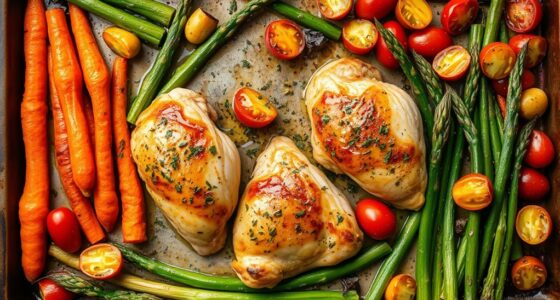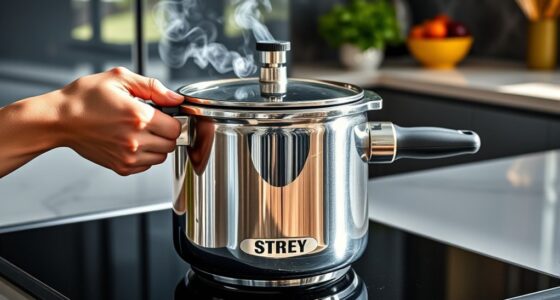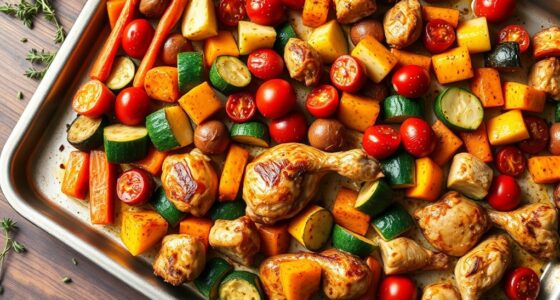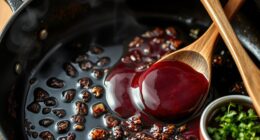To cut prep time quickly, focus on sharpening your knives regularly so they glide smoothly through ingredients. Use proper chopping techniques like rocking motions and guiding with knuckles to increase speed and safety. Maintain a relaxed grip and practice consistent movements to improve confidence and efficiency. Always use stable cutting surfaces and keep knives well-maintained. Mastering these skills can make a noticeable difference—continue exploring for more tips to boost your kitchen speed even further.
Key Takeaways
- Use a rocking motion with the tip of the knife kept on the cutting board for faster chopping.
- Guide the knife with knuckles to ensure accuracy and safety during quick cuts.
- Keep knives sharp through regular honing and sharpening to reduce cutting effort and increase speed.
- Maintain a relaxed grip and proper technique to minimize fatigue and improve chopping efficiency.
- Practice consistent, controlled movements to build confidence and speed in your cutting skills.

Ever wondered how professional chefs chop their prep time so efficiently? The secret isn’t just their speed; it’s their mastery of knife skills. When you focus on proper technique, you can markedly cut down your prep time without sacrificing safety or quality. The first step is understanding knife safety. Keeping your knife sharp is essential—not only does it make cutting easier, but it also prevents accidents. A dull blade requires more force, increasing the risk of slips and cuts. Always handle knives carefully, holding the handle firmly and avoiding placing fingers near the blade’s edge. Use a stable cutting surface, like a wooden or plastic cutting board, to prevent slipping. When not in use, store your knives securely in a knife block or with blade guards to avoid accidental nicks and ensure the blades stay sharp longer. Developing good knife safety habits is the foundation for efficient and safe chopping.
Next, focus on knife maintenance. Regularly sharpening your knife keeps the edge precise and reduces the effort needed when chopping. You don’t need fancy equipment—just a sharpening stone or a honing rod will do. Hone your knife before every session to realign the edge and keep it responsive. A well-maintained knife glides through ingredients smoothly, allowing you to work faster. Also, clean your knives immediately after use, hand washing with warm soapy water and drying thoroughly to prevent rust or corrosion. Proper maintenance extends the lifespan of your blades and ensures consistent performance, enabling you to work swiftly and safely.
Once you’ve mastered knife safety and maintenance, you can focus on the actual chopping techniques. Use a rocking motion, keeping the tip of the knife on the cutting board while moving the handle up and down. This technique allows for quick, controlled cuts. Practice guiding the knife with your knuckles, not your fingertips, to maintain accuracy and safety. With consistent practice, your chopping speed increases because you become more confident and precise in your movements. The key is to stay relaxed—tension slows down your work and increases fatigue. Invest a little time to sharpen and clean your knives regularly, and you’ll notice a remarkable difference in your speed and safety, ultimately reducing your prep time and making cooking more enjoyable.
Frequently Asked Questions
What Are the Best Knives for Quick Chopping?
The best knives for quick chopping are high-quality, sharp chef’s knives with a sturdy, comfortable handle. To maintain their edge, regularly hone and sharpen them, ensuring clean cuts. Focus on proper cutting technique—use a rocking motion and keep your fingers curled under—to boost speed and safety. Well-maintained knives and refined cutting skills help you chop faster, reducing prep time and making cooking more efficient.
How Do You Maintain a Sharp Knife?
To keep your knife sharp, you need regular knife sharpening and proper knife maintenance. Use a whetstone or a sharpening steel to hone the blade, ideally after every few uses, to realign the edge. Avoid cutting on hard surfaces like glass or stone, and hand wash your knives promptly to prevent corrosion. By practicing consistent knife maintenance, you’ll guarantee your blades stay sharp and safe for quick, efficient chopping.
What Safety Tips Improve Chopping Speed?
Imagine your knife as an extension of your hand—trust your grip. To improve chopping speed safely, always use a proper grip and wear a knife glove for added safety. Keep your fingers tucked and away from the blade’s path, and focus on controlled, deliberate cuts. These safety tips prevent accidents and boost confidence, allowing you to work faster without sacrificing precision or safety.
Can Specific Cutting Boards Speed up Prep?
Yes, using specific cutting boards can speed up your prep. Opt for durable materials like bamboo or plastic, which resist knife marks and stay level for safer chopping. Eco-friendly options like bamboo are also great, as they’re sustainable and gentle on knives. With a sturdy, well-maintained board, you’ll cut faster and more efficiently, reducing prep time and making your cooking process smoother.
How Do Professional Chefs Train for Faster Chopping?
You train for faster chopping by practicing precision and speed, much like a knife thrower honing their aim in culinary competitions. While it sounds intense, consistent repetition builds muscle memory, enabling quicker cuts. Focus on proper technique, hand positioning, and knife grip. Just as knife throwing requires focus, so does sharpening your skills. Over time, you’ll chop faster, safer, and more confidently, turning prep into a swift, seamless part of your cooking routine.
Conclusion
Mastering mindful, methodical knife skills dramatically diminishes your prep time, transforming tedious tasks into swift, satisfying routines. With consistent practice, you’ll become confident, cutting corners cleverly and cooking with greater convenience. Embrace these chopping tricks to cultivate competence, curb clutter, and create culinary clarity. By honing your hacks, you’ll handle herbs, vegetables, and more with precision and speed—making mealtime more manageable, memorable, and, ultimately, more enjoyable.









